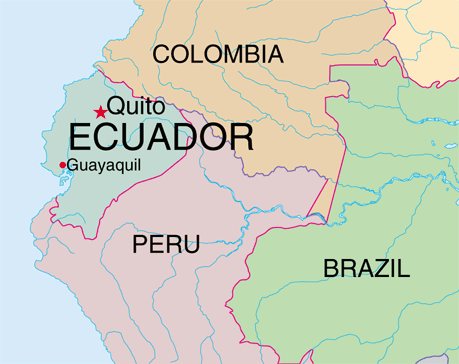In
1835, Captain Robert FitzRoy navigated the HMS Beagle out into the Pacific
Ocean about 600 miles west of Ecuador to the Galápagos Islands. And on his ship
was the famous naturalist Charles Darwin.
It was here that his observations in finding that certain birds and
tortoises differed between the islands.
Much of his research here was included in his infamous work On the Origin of Species. (Fascinating
book – I read it several years ago.)
Those tortoises, by the way, are the largest living species of tortoise
in the world.
 |
| This one named Harriet (which also happens to be my other name) lived to be 176 years old. |
Ecuador
itself lies in the northwest corner of South America, surrounded by Columbia to
the north, Peru to the south and east, and the Pacific Ocean to the west. The Andes Mountains run through the
center of the country, separating the coastal regions and highlands in the west
from the Amazon Rainforest regions in the east. Ecuador gets its name from its location about a ¼ of a
degree south of the equator.
Ecuador
has a wide variety of climates: from temperate and dry in the Andes Mountains,
to subtropical on the coastal and rainforest regions. These vast changes in climate also contribute to a wide
variety of flora and fauna as well.
Ecuador is considered one of the 17 countries who has the largest
biodiversity – and per square kilometer, Ecuador has the most. Because of its location close to the
equator, the sun rises and sets pretty much the same time year round – around
6am and 6pm, give or take about a half-hour.
The
capital city is Quito, or more formally San Francisco de Quito. It’s considered the highest capital
city in the world that houses the administrative, legislative, and judicial
branches of the government. (As
opposed to the capitals of Bolivia, who splits those branches between the two
cities.) While Quito is the
capital city, it’s not the largest city in Ecuador; that honor goes to the
coastal city and cultural hotspot of Guayaquil. Quito’s historic center is one of the best-preserved and
least-altered cultural centers in the world. It was also declared as the first UNESCO World Cultural
Heritage Sites in 1978.
Ecuador’s
economy has more or less risen consistently since 2000. That was the year that Ecuador adopted
the US Dollar as their legal tender, abandoning the sucre. Even though there were some rocky
times, especially during the global economic crisis of 2008, it seems to have
recovered: unemployment was around 4.8% in 2012, and the extreme poverty rate
went from around 40% in 2001 to around 17.4% in 2011. Crude petroleum accounts for about 46% of Ecuador’s
exports. They’re also a major
exporting country of bananas and plantains, flowers, and cocoa, as well as
shrimp, sugar cane, rice, cotton, corn, palm, and coffee.
The
official language is Spanish, and it’s the language that most Ecuadorians
speak. However, a large number of
them also speak Amerindian languages, the largest being Quichua, part of the
Quechua group of languages.
The New York Times published their “52 Places
to Go in 2014” recently, and Ecuador came in #7. Their recently refurbished train called Tren Crucero is
proving to be a new and awe-inspiring way to see the country. It starts in Quito and winds its way
through the Andes Mountains and past volcanoes to the city of Guayaquil. Cotopaxi National Park is also a
popular side trip for great opportunities to see a lot of the local
wildlife. I think Ecuador would
make a great trip, and perhaps, one day I can make it down there.
Up
next: holidays and celebrations




No comments:
Post a Comment